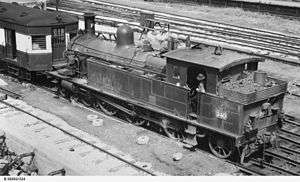South Australian Railways F class (1902)
South Australian Railways
F Class|

South Australian Railways F240, 1952. |
| Type and origin |
|---|
| Power type |
Steam |
|---|
| Builder |
- S.A.R. Islington Workshops (21)
- James Martin & Co. (12)
- Perry Engineering (10)
|
|---|
| Total produced |
44 |
|---|
|
|
|
| Performance figures |
|---|
| Maximum speed |
60 mph |
|---|
| Tractive effort |
18,335 lbf (81.56 kN) |
|---|
|
|
|
The South Australian Railways F class was a class of broad gauge 4-6-2 tank engines operated by South Australian Railways.[1][2]
The class hauled the majority of Adelaide's suburban passenger trains from its introduction in the early 1900s. The type replaced the smaller P class 2-4-0T engines, which were struggling with the increasing sizes of suburban passenger trains. From the 1930's, F class locomotives were replaced by 55 and 75 class Brill railcars on lightly patronised routes. They continued to see extensive service on popular routes until their displacement in 1955-56 by Redhen diesel multiple units. Some engines were retained for shunting duties at Port Adelaide and Mile End with F225, the final member of the class being condemned in 1969. [3]
The locomotives had saturated steam boilers and were considered attractive. While slow to accelerate away from stations, the locomotives were capable of reaching speeds of up to 60 mph (100 km/h). They were a capable locomotive, they faced few restrictions, except for the Belair branch operations which were limited to 3 carriages.[4]
In total there were 44 members of the class. The first member of the class was built in 1902 but the South Australian Railways' Islington Workshops. The Islington workshops built 22 locomotives. James Martin & Co. of Gawler built 12 units, with the remaining 10 built by Perry Engineering. Perry Engineering built F255, the final member of the class, which entered service in October 1922.[5]
Three members of the class avoided the scrapper's torch. F249 is on display at the Gawler, South Australia railway station. F255, the final member of the class, survives in the collection of the National Railway Museum.
F251 survived in working order. The Steamranger tourist railway operator acquired it in 1981. It saw heavy in the 1990's while the tourist railway's Rx, 520 and 620 class locomotives were being overhauled. It was underpowered however and placed into storage. There are currently no plans to restore it to a working condition again.[6]
| F class locomotives |
|---|
| South Australian Railways F 242 hauling a passenger train at Eden Hills, 1952. |
| South Australian Railways F 242 hauling a passenger train at Clapham, 1952 |
| South Australian Railways F 176 and F 177, 1951 |
|
References
|
|---|
| | Steam locomotives – 1,435 mm (4 ft 8 1⁄2 in) gauge | |
|---|
| | Steam locomotives – 1,067 mm (3 ft 6 in) gauge | |
|---|
| | Diesel locomotives | |
|---|
| | Railcars | |
|---|
| | Electric multiple units | |
|---|
| | Carriages | |
|---|
|



